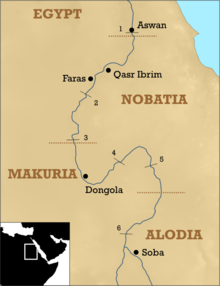Nubia in the Middle Ages
The history of Nubia and Sudan in the Middle Ages is mainly determined by the Christian empires of Makuria and Alwa (Alodia). Although these realms were never really forgotten, it wasn't until the 1960s that research began to focus on them. A trigger for this awakened interest in Christian Nubia was the excavation that began in 1961 on the settlement hill ( Kom ) of Faras , during which the cathedral of Faras , richly painted with Christian motifs , was exposed. This discovery demonstrated the high level of art and culture in medieval Nubia.
swell
The northern of the two Christian kingdoms, Makuria, was in constant conflict with Muslim Egypt, and the country's fortunes, as far as military conflicts are concerned, are therefore relatively well known by Arabic writers. The Arabic sources are still not without problems. It is often difficult to identify certain king names, different sources contradict each other and above all Makuria appears as an opponent and is therefore not always presented in the best light. Besides, we learn little of events in peacetime. There were fewer contacts with the southern Alwa on the part of the Arab world and therefore this empire is comparatively little mentioned in the Arab sources. Only a few kings are known by name. This kingdom therefore remains very puzzling to us.
In addition to the Arabic sources, Byzantine sources play a certain role, especially for the early days of the Christian empires and Christianity in particular.
Archaeological excavations have produced rich material on the culture of the two kingdoms, with Lower Nubia being very well explored, while few places in the Alwa kingdom have been excavated.
prehistory
After the collapse of the Meroitic Empire in the 4th century AD, three successor states emerged, which in many cases continued Meroitic traditions. Only the history of the northernmost of these states ( Nobatia ) can so far be traced in broad outline. In the middle lay the empire of Makuria and in the far south Alwa . In the seventh century these empires were Christianized, with Nobatia and Alwa belonging to the Monophysite and Makuria to the Melkite faith. However, during the seventh century, Makuria also became Monophysite. This is probably related to the fact that the Melkite belief system had its center especially in Constantinople. After conquering many Byzantine provinces in the east, direct contact with Byzantium became more difficult and the Nubians turned more to the Patriarch of Alexandria , who was Monophysite.
The Christian empires
Nobatia became a province of Makuria as early as the 6th century, shortly after Christianization. It is unknown whether this incorporation was military or peaceful. The capital of Makuria was Dongola , which subsequently developed into an important Christian city. There were several richly decorated churches, monasteries and palaces.
The empire of Makuria extended mainly in Lower Nubia to around the 5th Nile Cataract. To the south of it joined the empire of Alwa. Its southern extent is unknown. The southernmost church was at Khalil al-Kubra , about 40 km south of Sannar . The east and west extent of both empires is unknown, but outposts existed in the steppe areas in the south-west and economic relations up to today's Darfur .
The economic basis of the Christian empires was certainly agriculture, although the fertile land on the Nile, especially in northern Sudan, was never very wide and therefore could not support a large population. Larger cultivation areas can only be expected in the south, in Alwa.
The end of the Christian empires
The end of Makuria began in the 13th century. One of the last Nubian churches was a small adobe building in Kulubnarti (130 kilometers upriver from Wadi Halfa ), dated to the 13th or 14th century. Many details have been handed down by Arab historians, but it is still difficult to create an overall picture. Since the middle of the 13th century there have been more and more Arab attacks on Nubia. The sultans in Egypt apparently tried to gain more and more influence over Makuria. There were never any conquests, but these constant wars seem to have drained the country.
See also
literature
- Siegfried G. Richter : Studies on the Christianization of Nubia. (= Languages and Cultures of the Christian Orient , Volume 11) Reichert, Wiesbaden 2002, ISBN 3-89500-311-5
- Derek A. Welsby : The Medieval Kingdoms of Nubia. Pagans, Christians and Muslims along the Middle Nile . British Museum Press, London 2002, ISBN 0-7141-1947-4 .
Individual evidence
- ^ Friedrich Wilhelm Deichmann , Peter Grossmann : Nubian research. German Archaeological Institute. Gebr. Mann Verlag, Berlin 1988, p. 45
